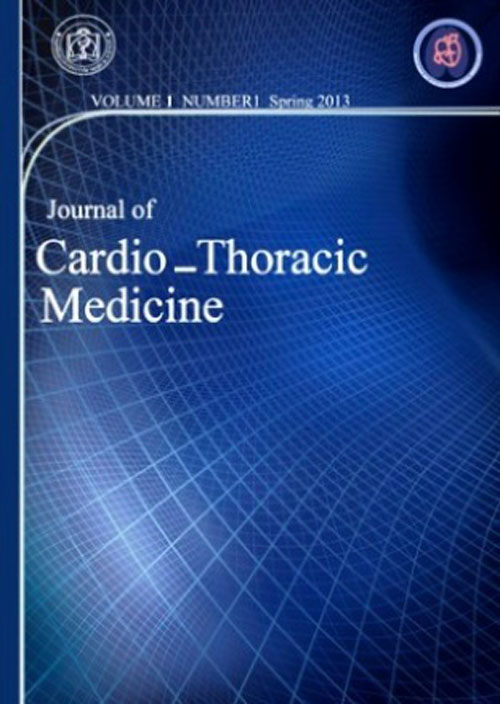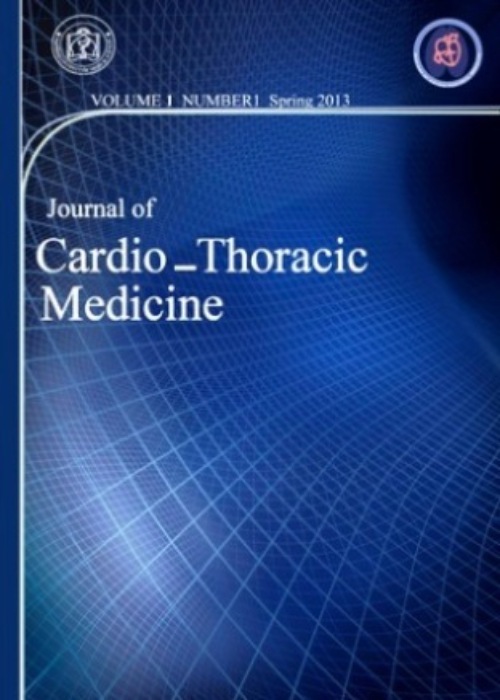فهرست مطالب

Journal of Cardio -Thoracic Medicine
Volume:9 Issue: 1, Winter 2021
- تاریخ انتشار: 1399/12/24
- تعداد عناوین: 8
-
-
Pages 734-738Introduction
Delirium is a fluctuating type of cognitive impairment and is common in hospitalized patients and after open heart surgery has been reported up to 90%, which leads to increased risk of dementia and hospitalization costs, reduced quality of life, risk of falls. Needs long-term care and etc. Activation of the deep inflammatory response dependent on the blood response and the cardiopulmonary pump circuit is one possible reason for this. Therefore, in this study, two anti-inflammatory drugs, dexamethasone and methylprednisolone, were used in Prime solution in cardiac surgery patients and then the occurrence of delirium was evaluated .
Methods and Materials:
In this clinical trial study with a sample volume size 43 patients in open-heart surgery by on-pump method, after random assignment to two groups including dexamethasone and methylprednisolone that were added to prime solution. Inclusion criteria were EF more than 30%, candidate for mitral valve surgery, absence of cognitive impairment and preoperative delirium and age range 30-65 years. In the first group with 21 patients received dexamethasone at a dose of 0.1 mg/ kg and in the second group with 22 patients at a dose of 0.4 mg/Kg in prime solution. Then delirium examined with standard CAM-ICU instruments after extubation and then the results were analyzed with SPSS 21 version.
ResultsThe results showed that only 18% of patients who received methylprednisolone primer solution and 28% of patients who received dexamethasone primer solution had delirium, and this difference was non-significant (P. value: 0.448).
ConclusionIn this study, the anti-inflammatory drug methylprednisolone were not superior to each other and had a similar effect on delirium
Keywords: Delirium, open-heart surgery, Dexamethasone, Methylprednisolone -
Pages 739-746Introduction
Hypertension is recognized as one of the major causes of cardiovascular disease. The present study aimed to assess the relationship between hypertension and its risk factors in the population referring to comprehensive health care centers affiliated to Mashhad University of Medical Sciences.
Materials and MethodsThis case-control study was performed on the health assessment data of the population aged 30 years and above registered in the SINA system in 2017-2018. The present case-control study was conducted on 1500 cases who were selected by systematic random sampling and assigned to the case group (500 hypertensive patients) and control group (1000 subjects without a history of hypertension). Data were analyzed using SPSS software (version 22). A p-value less than 0.05 was considered statistically significant.
ResultsBased on the results, the risk factors for hypertension included settlement in urban areas (OR=2.914), body mass index≥ 25 (OR = 2.522), waist circumference˃90 (OR=2.409), sedentary lifestyle (OR=2.373), consumption of solid oil (OR=1.581), triglyceride level of ˃150 (OR=566), use of table salt (OR=1.547). On the other hand, the following were identified as protective factors against hypertension: hard labor jobs (OR=0.292), optimal physical activity (OR=0.421), and regular consumption of vitamin D (OR=0.625) (p <0.05).
ConclusionThe results will not only provide a solid foundation on potency of risk factors and protective factors for hypertension but will also give an invaluable insight to the health planning programs. The reduced prevalence of hypertension can be planned for with the identification of related risk and protective factors.
Keywords: Hypertension, Relative frequency, Risk factors -
Pages 747-754Introduction
It has beenproposed that regular aerobic exercisetraining and medicinal plants are able to reduce oxidative damage resulted from toxin metal poisoning such as arsenic which is a significant risk factor in the heart diseases. The purpose of this research is to evaluate the simultaneous effect of regular aerobic exercise training and pumpkin extract on oxidative stress of the heart and endothelial cells of the aorta in rats poisoned with arsenic.
Materials and Methods56 male Wistar rats were divided into seven groups including TC (toxic control); AE (aerobic exercise training); TAP1 (toxic aerobic exercise training + 300 mg/kg/day pumpkin seed extract consumption); TAP2 (toxic aerobic exercise training + 600 mg/kg/day pumpkin seed extract consumption); TP1 (300 mg/kg/day toxic pumpkin seed extract consumption); TP2 (600 mg/kg/day toxic pumpkin seed extract consumption), and HC (healthy control). The intervention was performed based on the groups' categorization. 24 hours after the last intervention the samples were collected. Statistical analyses were performed using one and two-way analysis of variance (ANOVA).
ResultsThe results showed that exercise training increased GSH (p= 0.0001) and GSSG (p= 0.0001) and declined MDA levels (p= 0.0001) in the aortic endothelial cells and heart tissue. Also, pumpkin seed extract consumption induced a significant increase in GSH (p= 0.0001) and GSSG (p= 0.0001) and decreased MDA levels (p= 0.0001) in the aortic endothelial cells and heart. On the other hand, interaction of exercise training and pumpkin seed extract consumption increased GSH (p= 0.0001) and GSSG (p= 0.0001) and decreased MDA levels (p= 0.0001) in the aortic endothelial cells and heart.
ConclusionIt is concluded that concurrent of pumpkin seed extract consumption and aerobic exercise training could intensify mutual antioxidant effects in oxidative stresses such as cardiac disorders caused by arsenic poisoning.
Keywords: Endothelial Cells Glutathione, Malondialdehyde Glutathione-Disulfide, regular aerobic exercise, Oxidative Damage -
Pages 755-761IntroductionNovel Coronavirus outbreak has posed a global threat. While the infection appears to be mild in most patients, considering its high rate of transmission, a large number of people are at risk of developing severe to critical illness in total which makes prognosis studies a priority.The aim of the present study was to evaluate red blood cell distribution width (RDW) as a predictive factor for diagnosing severe cases of coronavirus disease 2019 (COVID-19).Materials and MethodsA total number of 204 inpatients diagnosed with COVID-19 including 122 men and 82 women (Mean age: 58.83±15.93 years old) treated at Imam Reza Hospital, Mashhad, Iran were included in the study. Patients were divided into severe and moderate groups according to their clinical signs and examinations and pulmonary imaging features. Demographic Data, laboratory test results, treatments, patients’ complications and outcome were recorded. Mann-Whitney U test and spearman correlation coefficient (r) were performed to assess RDW correlation with severity and serious complications in patients including intensive care unit (ICU) admission, shock, secondary infections, intubation, length of hospitalization and death. Receiver operating characteristics (ROC) curves analysis was carried out to define the reliability of RDW as a predictive indicator in severe COVID-19.ResultsThe results showed statistical significant correlations between high levels of RDW and developing secondary infections and longer hospitalization (P values ≤0.001). The optimal cutoff for RDW to predict the length of hospitalization (≤ 7 days or more than 7 days) was estimated to be 14.65% with 94% sensitivity and 71.3% specificity. The area under curve was calculated to be 0.895 through Roc curve analysis.ConclusionHigh predictive value of RDW, a routine blood test parameter, could be used in diagnosing COVID-19 patients at higher risk for developing secondary infections and longer hospital stay which in turn helps with better management of the disease.Keywords: Coronavirus Disease-19, Prognosis, Secondary Infection, Red Blood Cell Distribution Width
-
Pages 762-768
This randomized clinical trial was aimed to assess the efficacy of neoadjuvant letrozole in combination with standard neoadjuvant chemotherapy regimen on clinical response rate of hormone receptor positive locally advanced breast cancer.In this randomized clinical study, 42 female patients, ≥ 18 years, with clinical stage IIB-IIIC (T1-4, N0-3, M0), pathologically proven hormone receptor positive and HER2 negative, invasive ductal carcinoma of breast, were randomly assigned to receive standard neoadjuvant chemotherapy alone (control group) or letrozole 2.5 mg/d (in association with goserlin in premenopausal patients) concurrent with standard neoadjuvant chemotherapy (study group). Standard neoadjuvant chemotherapy regimen has consisted of 4 cycles of doxorubicin (60mg/m2) and cyclophodphamide (600mg/m2), followed by 4 cycles of paclitaxel (175mg/m2) every two weeks.At the beginning of the study all patients underwent thorough exmination of breast mass and axillary lymph nudes by palpation and ultrasonography. At the end of the study response rates were also evaluated by palpation and ultrasonography and subsequently patients were referred for surgury. Pathologic response rates were also evaluated on surgical specimens. All of the clinical, ultrasonographic and pathologic examinations during the trial were performed by a single specialist. Finally all the data were analysed statistically.Overall clinical response rates in breast were 95.2%, in both study and control group. Overall clinical response rates in axilla were 80.9% and 76.2% in study and control group respectively. Similarly, overall radiologic complete response rates in breast and axilla were 95.2% and 76.2% respectively in both study and control group. Totally, the comparison of overall clinical and radiologic response rates in th breast and axilla, showed no significant difference between control and study group (p>0.05).The addition of letrozol to standard neoadjuvant chemotherapy regimen was not associated with higher clinical and radiologic response rates in patients with locally advanced hormon receptor positive breast cancer.Keywords: Neoadjuvant chemotherapy, Letrozole, Locally advanced breast cancer
Keywords: Neoadjuvant chemotherapy, Letrozole, locally advanced breast cancer -
Pages 769-772
Ventricular septal rupture (VSR) is a life-threatening complication of myocardial infarction (MI). Surgery remains the only option; however it is still a challenging (1). Patients survive following medical management have poor outcome, so, its result is disappointing (2). Primary percutaneous coronary intervention (PCI) can be reduced VSR incidence. Medical treatment has high mortality, and early surgery is recommended to prevent hemodynamic deterioration. However, surgery also associated to a high of mortality rate (3). Transcatheter device closure is an option in critical cases (4).
Keywords: Acute myocardial infarction, Ischemic Ventricular Septal Defect, Post Infarction Mechanical Complications, Ventricular Septal Rupture -
Pages 773-776
Sarcoidosis is an idiopathic, noncaseating granulomatous disorder with wide systemic involvement. Lungs, eyes, and skin are the organs most commonly affected. Bone involvement, which is very rare, was reported as present in 3 to 13% of affected cases. Here we present a case of young female with ribs, vertebrae and pulmonary involvement, lesion mimicking as metastasis or tuberculosis thus emphasizing the importance of differential diagnosis.
Keywords: Skeletal, Sarcoidosis, Metastasis, Vertebrae -
Pages 777-779
The syndrome of combined emphysema of the upper lobes and fibrosis of the lower lobes on chest computed tomography results in a characteristic functional profile, with preserved lung volumes, hypoxemia at exercise. Despite subnormal spirometry, combined pulmonary fibrosis and emphysema is a severe entity. The presence of pulmonary arterial hypertension at diagnosis is a critical determinant of prognosis.
Keywords: CPFE, Emphysema, Pulmonary Fibrosis


